2011 NISSAN MURANO belt
[x] Cancel search: beltPage 43 of 433

Black plate (41,1)
Model "Z51-D" EDITED: 2010/ 7/ 23
install a forward-facing child
restraint in the front seat, see
“FORWARD-FACING CHILD RE-
STRAINT INSTALLATION USING
THE SEAT BELTS” later in this
section.
— Even with the NISSAN Advanced Air Bag System, never install a
rear-facing child restraint in the
front seat. An inflating air bag
could seriously injure or kill a
child. A rear-facing child re-
straint must only be used in the
rear seat.
—Besuretopurchaseachild restraint that will fit the child
and vehicle. Some child re-
straints may not fit properly in
your vehicle.
— Child restraint anchor points are designed to withstand loads
from child restraints that are
properly fitted.
— Never use the anchor points for adult seat belts or harnesses.
— A child restraint with a top tether strap should not be used in the
front passenger seat.
— Keep seatbacks as upright as possible after fitting the child
restraint.
— Infants and children should al- ways be placed in an appropri-
ate child restraint while in the
vehicle.
. When the child restraint is not in
use, keep it secured with the LATCH
system or a seat belt. In a sudden
stop or collision, loose objects can
injure occupants or damage the
vehicle.
CAUTION
A child restraint in a closed vehicle can
become very hot. Check the seating
surface and buckles before placing a
child in the child restraint.
This vehicle is equipped with a universal child
restraint anchor system, referred to as the
LATCH (Lower Anchors and Tethers for CHil-
dren) system. Some child restraints include rigid
or webbing-mounted attachments that can be
connected to these anchors.
For details, see “Lower Anchors and Tethers for
CHildren (LATCH) System” later in this section. If you do not have a LATCH compatible child
restraint, the vehicle seat belts can be used.
Several manufacturers offer child restraints for
infants and small children of various sizes. When
selecting any child restraint, keep the following
points in mind:
.
Choose only a restraint with a label certifying
that it complies with Federal Motor Vehicle
Safety Standard 213 or Canadian Motor
Vehicle Safety Standard 213.
. Check the child restraint in your vehicle to
be sure it is compatible with the vehicle’s
seat and seat belt system.
. If the child restraint is compatible with your
vehicle, place your child in the child restraint
and check the various adjustments to be
sure the child restraint is compatible with
your child. Choose a child restraint that is
designed for your child’s height and weight.
Always follow all recommended procedures.
All U.S. states and Canadian provinces or
territories require that infants and small
children be restrained in an approved child
restraint at all times while the vehicle is
being operated. Canadian law requires the
top tether strap on forward-facing child
restraints to be secured to the designated
anchor point on the vehicle.
Safety — Seats, seat belts and supplemental restraint system
1-27
Page 44 of 433
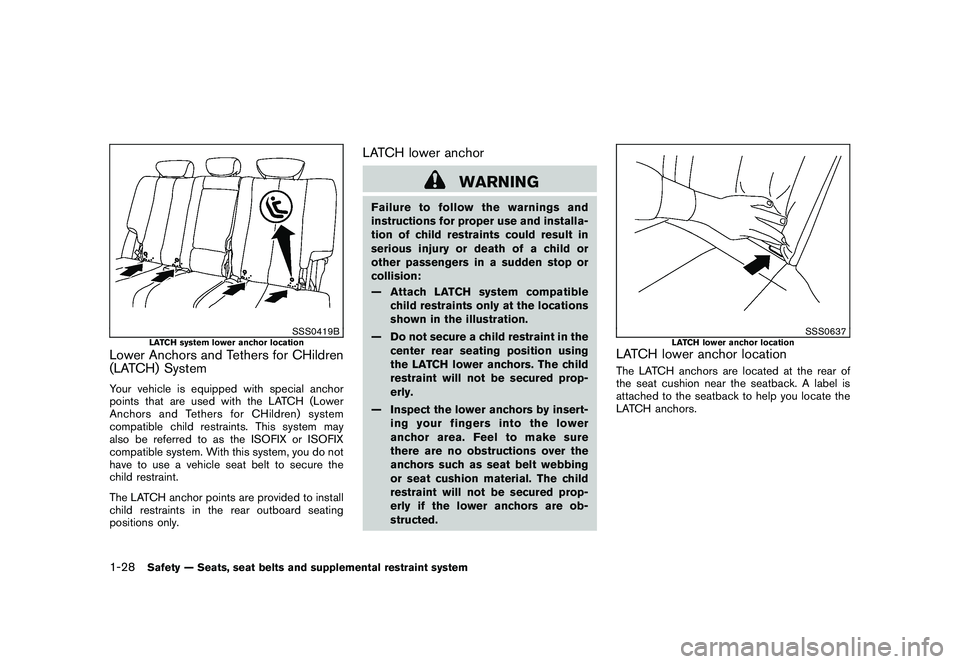
Black plate (42,1)
Model "Z51-D" EDITED: 2010/ 7/ 23
SSS0419B
LATCH system lower anchor location
Lower Anchors and Tethers for CHildren
(LATCH) SystemYour vehicle is equipped with special anchor
points that are used with the LATCH (Lower
Anchors and Tethers for CHildren) system
compatible child restraints. This system may
also be referred to as the ISOFIX or ISOFIX
compatible system. With this system, you do not
have to use a vehicle seat belt to secure the
child restraint.
The LATCH anchor points are provided to install
child restraints in the rear outboard seating
positions only.
LATCH lower anchor
WARNING
Failure to follow the warnings and
instructions for proper use and installa-
tion of child restraints could result in
serious injury or death of a child or
other passengers in a sudden stop or
collision:
— Attach LATCH system compatiblechild restraints only at the locations
shown in the illustration.
— Do not secure a child restraint in the center rear seating position using
the LATCH lower anchors. The child
restraint will not be secured prop-
erly.
— Inspect the lower anchors by insert- ing your fingers into the lower
anchor area. Feel to make sure
there are no obstructions over the
anchors such as seat belt webbing
or seat cushion material. The child
restraint will not be secured prop-
erly if the lower anchors are ob-
structed.
SSS0637
LATCH lower anchor location
LATCH lower anchor locationThe LATCH anchors are located at the rear of
the seat cushion near the seatback. A label is
attached to the seatback to help you locate the
LATCH anchors.
1-28
Safety — Seats, seat belts and supplemental restraint system
Page 45 of 433
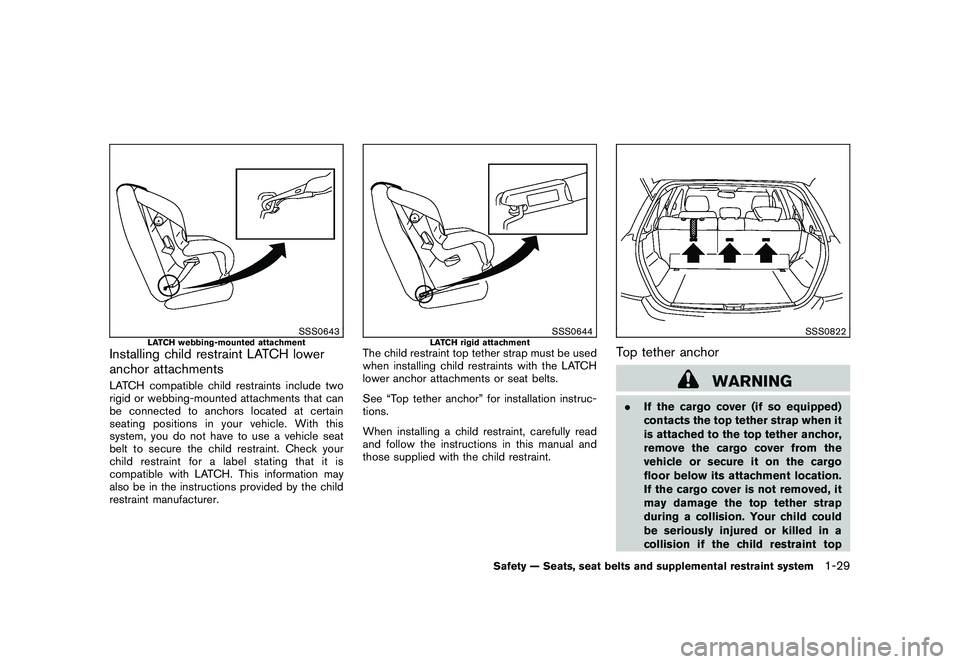
Black plate (43,1)
Model "Z51-D" EDITED: 2010/ 7/ 23
SSS0643
LATCH webbing-mounted attachment
Installing child restraint LATCH lower
anchor attachmentsLATCH compatible child restraints include two
rigid or webbing-mounted attachments that can
be connected to anchors located at certain
seating positions in your vehicle. With this
system, you do not have to use a vehicle seat
belt to secure the child restraint. Check your
child restraint for a label stating that it is
compatible with LATCH. This information may
also be in the instructions provided by the child
restraint manufacturer.
SSS0644
LATCH rigid attachment
The child restraint top tether strap must be used
when installing child restraints with the LATCH
lower anchor attachments or seat belts.
See “Top tether anchor” for installation instruc-
tions.
When installing a child restraint, carefully read
and follow the instructions in this manual and
those supplied with the child restraint.
SSS0822
Top tether anchor
WARNING
.If the cargo cover (if so equipped)
contacts the top tether strap when it
is attached to the top tether anchor,
remove the cargo cover from the
vehicle or secure it on the cargo
floor below its attachment location.
If the cargo cover is not removed, it
may damage the top tether strap
during a collision. Your child could
be seriously injured or killed in a
collision if the child restraint top
Safety — Seats, seat belts and supplemental restraint system
1-29
Page 46 of 433
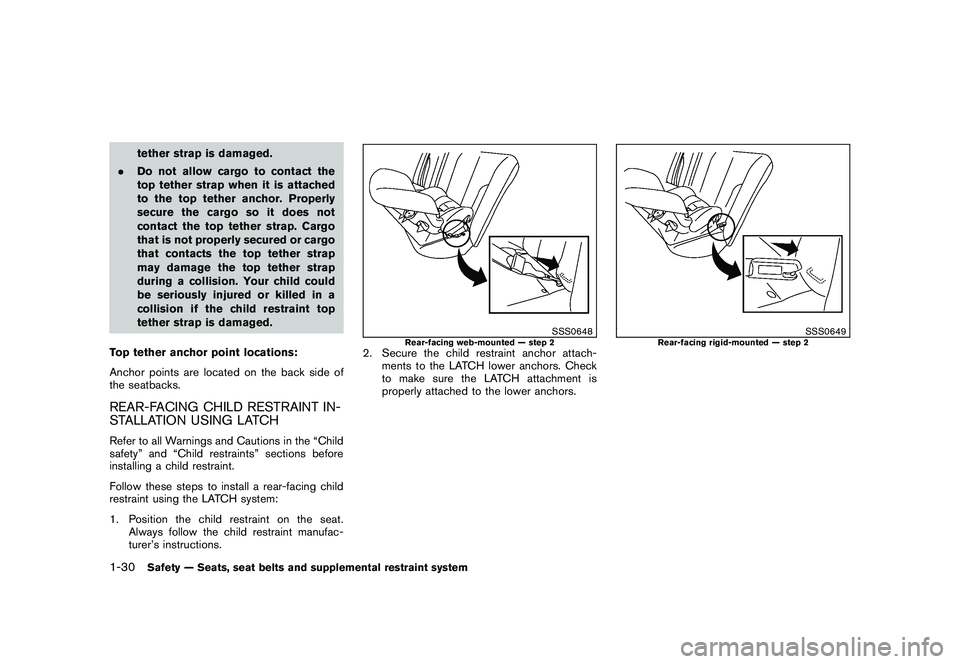
Black plate (44,1)
Model "Z51-D" EDITED: 2010/ 7/ 23
tether strap is damaged.
. Do not allow cargo to contact the
top tether strap when it is attached
to the top tether anchor. Properly
secure the cargo so it does not
contact the top tether strap. Cargo
that is not properly secured or cargo
that contacts the top tether strap
may damage the top tether strap
during a collision. Your child could
be seriously injured or killed in a
collision if the child restraint top
tether strap is damaged.
Top tether anchor point locations:
Anchor points are located on the back side of
the seatbacks.
REAR-FACING CHILD RESTRAINT IN-
STALLATION USING LATCHRefer to all Warnings and Cautions in the “Child
safety” and “Child restraints” sections before
installing a child restraint.
Follow these steps to install a rear-facing child
restraint using the LATCH system:
1. Position the child restraint on the seat. Always follow the child restraint manufac-
turer’s instructions.
SSS0648
Rear-facing web-mounted — step 2
2. Secure the child restraint anchor attach-ments to the LATCH lower anchors. Check
to make sure the LATCH attachment is
properly attached to the lower anchors.
SSS0649
Rear-facing rigid-mounted — step 2
1-30
Safety — Seats, seat belts and supplemental restraint system
Page 47 of 433
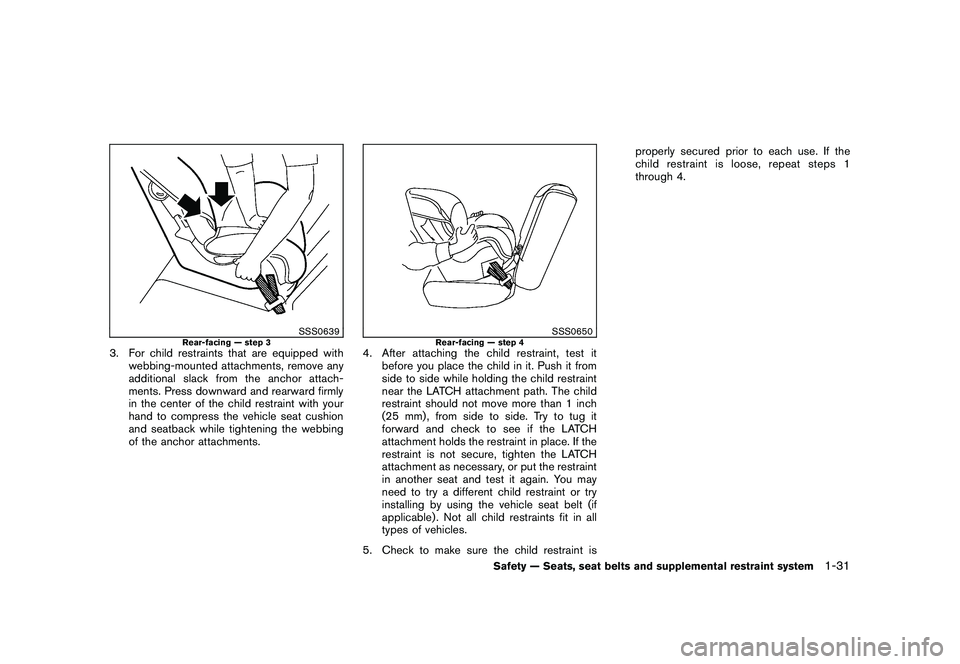
Black plate (45,1)
Model "Z51-D" EDITED: 2010/ 7/ 23
SSS0639
Rear-facing — step 3
3. For child restraints that are equipped withwebbing-mounted attachments, remove any
additional slack from the anchor attach-
ments. Press downward and rearward firmly
in the center of the child restraint with your
hand to compress the vehicle seat cushion
and seatback while tightening the webbing
of the anchor attachments.
SSS0650
Rear-facing — step 4
4. After attaching the child restraint, test itbefore you place the child in it. Push it from
side to side while holding the child restraint
near the LATCH attachment path. The child
restraint should not move more than 1 inch
(25 mm) , from side to side. Try to tug it
forward and check to see if the LATCH
attachment holds the restraint in place. If the
restraint is not secure, tighten the LATCH
attachment as necessary, or put the restraint
in another seat and test it again. You may
need to try a different child restraint or try
installing by using the vehicle seat belt (if
applicable) . Not all child restraints fit in all
types of vehicles.
5. Check to make sure the child restraint is properly secured prior to each use. If the
child restraint is loose, repeat steps 1
through 4.
Safety — Seats, seat belts and supplemental restraint system
1-31
Page 48 of 433
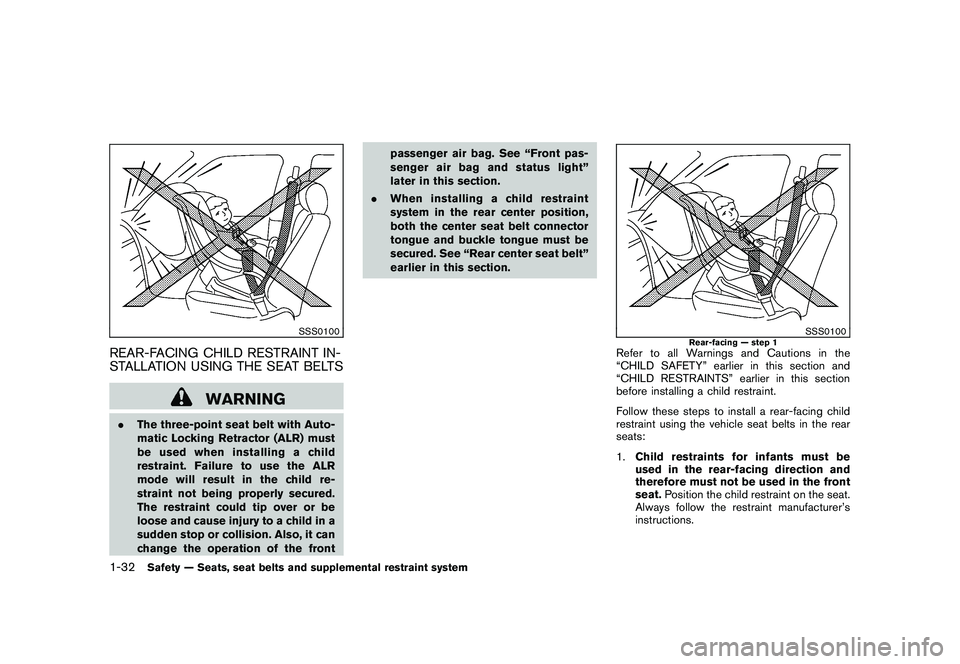
Black plate (46,1)
Model "Z51-D" EDITED: 2010/ 7/ 23
SSS0100
REAR-FACING CHILD RESTRAINT IN-
STALLATION USING THE SEAT BELTS
WARNING
.The three-point seat belt with Auto-
matic Locking Retractor (ALR) must
be used when installing a child
restraint. Failure to use the ALR
mode will result in the child re-
straint not being properly secured.
The restraint could tip over or be
loose and cause injury to a child in a
sudden stop or collision. Also, it can
change the operation of the front passenger air bag. See “Front pas-
senger air bag and status light”
later in this section.
. When installing a child restraint
system in the rear center position,
both the center seat belt connector
tongue and buckle tongue must be
secured. See “Rear center seat belt”
earlier in this section.
SSS0100
Rear-facing — step 1
Refer to all Warnings and Cautions in the
“CHILD SAFETY” earlier in this section and
“CHILD RESTRAINTS” earlier in this section
before installing a child restraint.
Follow these steps to install a rear-facing child
restraint using the vehicle seat belts in the rear
seats:
1.Child restraints for infants must be
used in the rear-facing direction and
therefore must not be used in the front
seat. Position the child restraint on the seat.
Always follow the restraint manufacturer’s
instructions.
1-32
Safety — Seats, seat belts and supplemental restraint system
Page 49 of 433
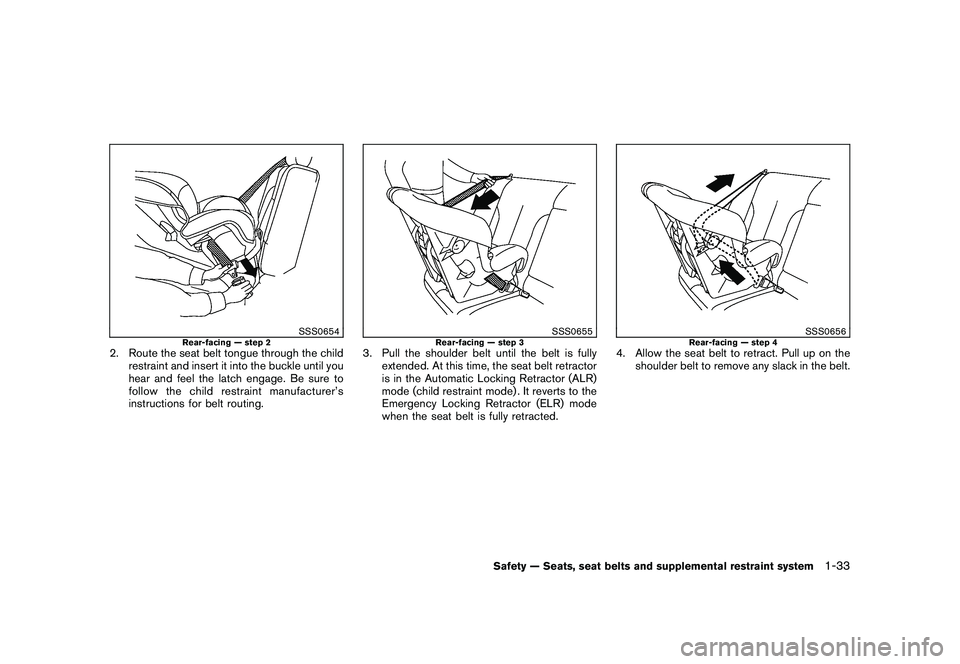
Black plate (47,1)
Model "Z51-D" EDITED: 2010/ 7/ 23
SSS0654
Rear-facing — step 2
2. Route the seat belt tongue through the childrestraint and insert it into the buckle until you
hear and feel the latch engage. Be sure to
follow the child restraint manufacturer’s
instructions for belt routing.
SSS0655
Rear-facing — step 3
3. Pull the shoulder belt until the belt is fullyextended. At this time, the seat belt retractor
is in the Automatic Locking Retractor (ALR)
mode (child restraint mode) . It reverts to the
Emergency Locking Retractor (ELR) mode
when the seat belt is fully retracted.
SSS0656
Rear-facing — step 4
4. Allow the seat belt to retract. Pull up on theshoulder belt to remove any slack in the belt.
Safety — Seats, seat belts and supplemental restraint system
1-33
Page 50 of 433
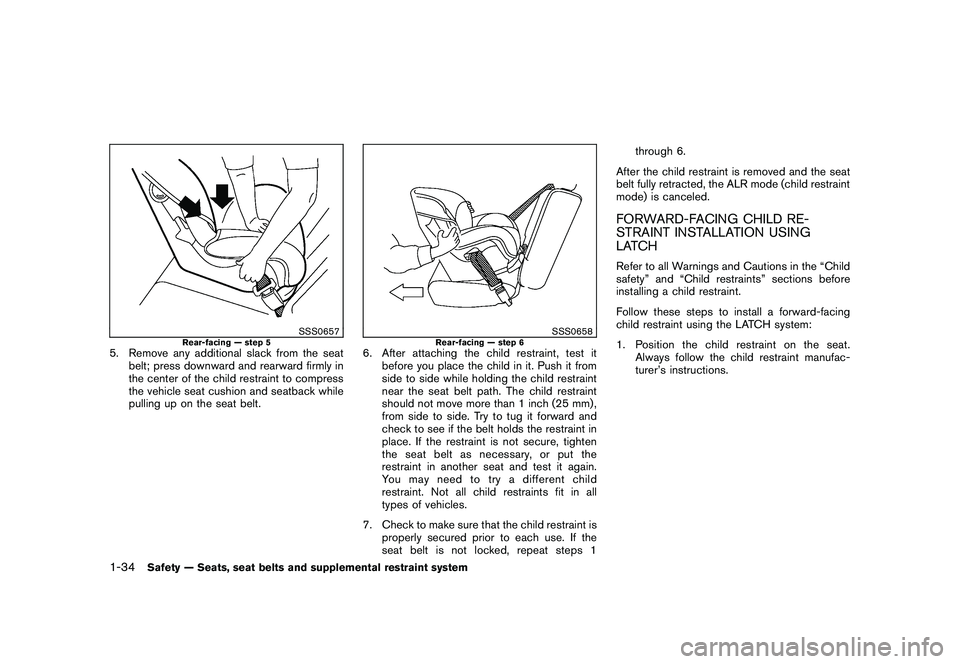
Black plate (48,1)
Model "Z51-D" EDITED: 2010/ 7/ 23
SSS0657
Rear-facing — step 5
5. Remove any additional slack from the seatbelt; press downward and rearward firmly in
the center of the child restraint to compress
the vehicle seat cushion and seatback while
pulling up on the seat belt.
SSS0658
Rear-facing — step 6
6. After attaching the child restraint, test itbefore you place the child in it. Push it from
side to side while holding the child restraint
near the seat belt path. The child restraint
should not move more than 1 inch (25 mm) ,
from side to side. Try to tug it forward and
check to see if the belt holds the restraint in
place. If the restraint is not secure, tighten
the seat belt as necessary, or put the
restraint in another seat and test it again.
You may need to try a different child
restraint. Not all child restraints fit in all
types of vehicles.
7. Check to make sure that the child restraint is properly secured prior to each use. If the
seat belt is not locked, repeat steps 1 through 6.
After the child restraint is removed and the seat
belt fully retracted, the ALR mode (child restraint
mode) is canceled.
FORWARD-FACING CHILD RE-
STRAINT INSTALLATION USING
LATCHRefer to all Warnings and Cautions in the “Child
safety” and “Child restraints” sections before
installing a child restraint.
Follow these steps to install a forward-facing
child restraint using the LATCH system:
1. Position the child restraint on the seat. Always follow the child restraint manufac-
turer’s instructions.
1-34
Safety — Seats, seat belts and supplemental restraint system